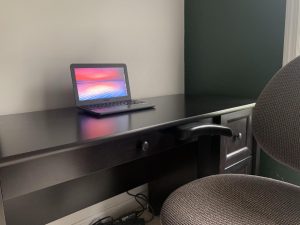Take it from a veteran: You will survive all-remote learning
Grace Hampton has been a remote student since school started. Now, all Baldwin students will be remote through December 11.
November 24, 2020
The district’s decision on Monday afternoon to move from a hybrid system to a completely remote model starting today through Dec. 11 will change the way a majority of students participate in school.
Unlike many students, I have been participating in remote learning since school began in September. While the change will be difficult for hybrid students, they will likely have a different remote experience than those who have stayed home for the past three months. And for the changes they will experience, I can offer some advice.
First, I was not a student forced into going remote. I made the decision with my family and never felt like my parents forced me into the model. Remote learning has not been easy, but it will become better now that all students are in the same situation.
The biggest problem that has come from remote learning has been how different teachers handle their classes. While many do a great job of incorporating remote learners, other classes unintentionally have made remote students feel disconnected from the classroom.
It is difficult to learn, for example, when a teacher is teaching to those in person and basically just allowing remote students to listen in. A quick “any questions from home?” does not equate to the quality of learning students that receive when an instructor can walk table to table, looking at work, pointing out issues, and addressing struggles.
Now that every class has temporarily moved online, however, this may change, as all students are stuck in the same situation will be receiving the exact same education as everyone else.
Another struggle remote learners have faced is when clubs and activities try to plan events to provide a sense of “normalcy” but do not incorporate all students. A simple dress up day or in-school celebration may not seem important, but they can make participation from remote students nearly impossible.
Despite the change today to all-remote, hybrid students have been experiencing remote learning two days out of the week all year, which should reduce their learning curve. For those who are struggling with the transition, however, there are many ways to stay motivated and continue to succeed.
The biggest piece of advice I can give other students is attend all Google Meet classes.
Unlike in the spring, it is nearly impossible to stay up to date with assignments and understand the material being taught unless students are on Google Meet during class time. Using a planner, setting alarms for class, and budgeting time have all helped me to continue learning and achieve desired grades despite the odd circumstances.
Also, students must make sure to wake up on time, even when it is difficult. If you slept in on an in-person day, you would miss out on classes, tests, and assignments. Virtual school is no different, and “I overslept” isn’t an excuse.
Finally, one of the hardest parts of remote learning, no doubt, is missing friends and losing face-to-face contact with peers and teachers.
FaceTime, texting, and other forms of social media, while sometimes addictive, provide great ways to keep in contact with others and get some human interaction. Also, looking for clubs hosting virtual meetings and events is a great way to meet new people and stay involved in the school community.





